Defeat of the German 1st Tank and 8th Field Armies in the Battle of Korsun-Shevchenko
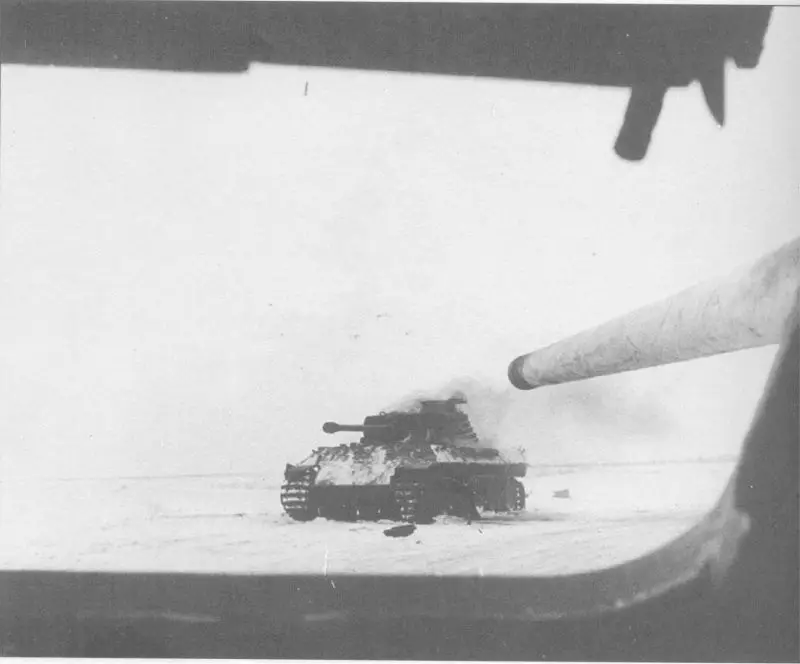
German tank Pz. Kpfw V "Panther", knocked out by a SU-85 self-propelled gun under the command of Lieutenant Kravtsev. Ukraine, 1944
"Ten Stalinist blows"
After defeat in the 1943 campaign, the Wehrmacht went on the defensive, trying to hold its positions as far as possible in the east, away from the main vital centers of the German Empire. On the Eastern (Russian) Front, the Nazis created a defense in depth; it already existed in the northern and central strategic directions.
But in the southern direction there is the line of the Dnieper, Russian troops broke through it in 1943. As a result, maneuver combat operations continued in the southern strategic direction in the winter of 1943–1944.
The strategic plan of the Soviet high command for the 1944 campaign was to defeat the Wehrmacht with a series of powerful successive blows: in the northern strategic direction - Army Group North, in the southern - Army Groups South and A. In the central direction, they initially planned to pin down enemy forces with offensive actions in order to facilitate the offensive in the north and south. That is, at first they planned to break up the strategic groupings of the Wehrmacht in the Leningrad region, in Right Bank Ukraine and in the Crimea. This created favorable conditions for the summer-autumn offensive campaign on the central sector of the front - in Belarus, the continuation of the offensive in the Baltic states and a breakthrough into the Balkans.
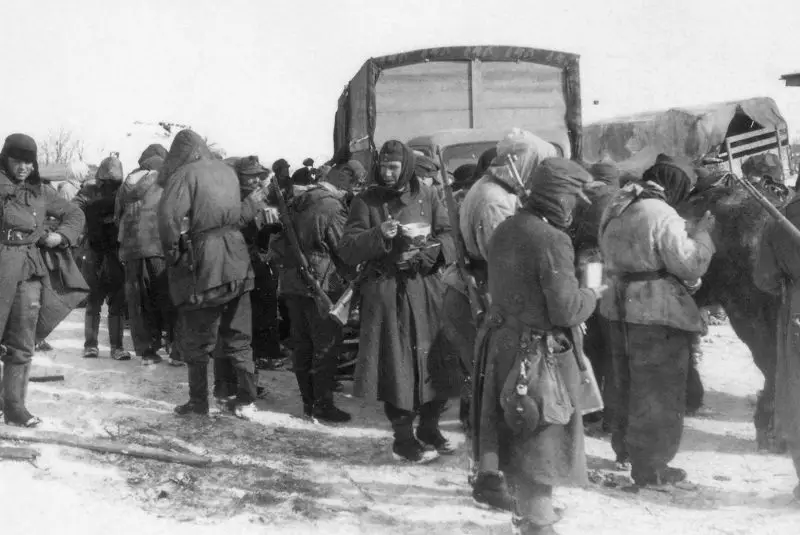
German soldiers have lunch on the street of the village during the Korsun-Shevchenko operation
Thus, the attacks were not carried out simultaneously along the entire length of the front, but sequentially, in different directions. This made it possible to concentrate strong strike groups of Soviet troops, which had a decisive superiority of forces and means over the Wehrmacht, especially in artillery, aviation and armored vehicles. Soviet shock fists were supposed to quickly break the enemy’s defenses, create large gaps in selected directions and build on their success.
To disperse the Wehrmacht's reserves, operations alternated in time and were carried out in areas significantly distant from each other. The main offensive operations were planned in the southern direction with the goal of completely liberating Ukraine and Crimea.
The first in time was the operation in the northern direction - the Leningrad, 2nd Baltic and Volkhov fronts ("January Thunder" How the German 18th Army was driven back from Leningrad). Our troops had to finally lift the blockade from Leningrad and reach the borders of the Soviet Baltic republics occupied by the enemy.
These operations entered into history under the name “Ten Stalinist strikes” and led to the complete liberation of Soviet territory from invaders and the transfer of hostilities of the Red Army outside the USSR.
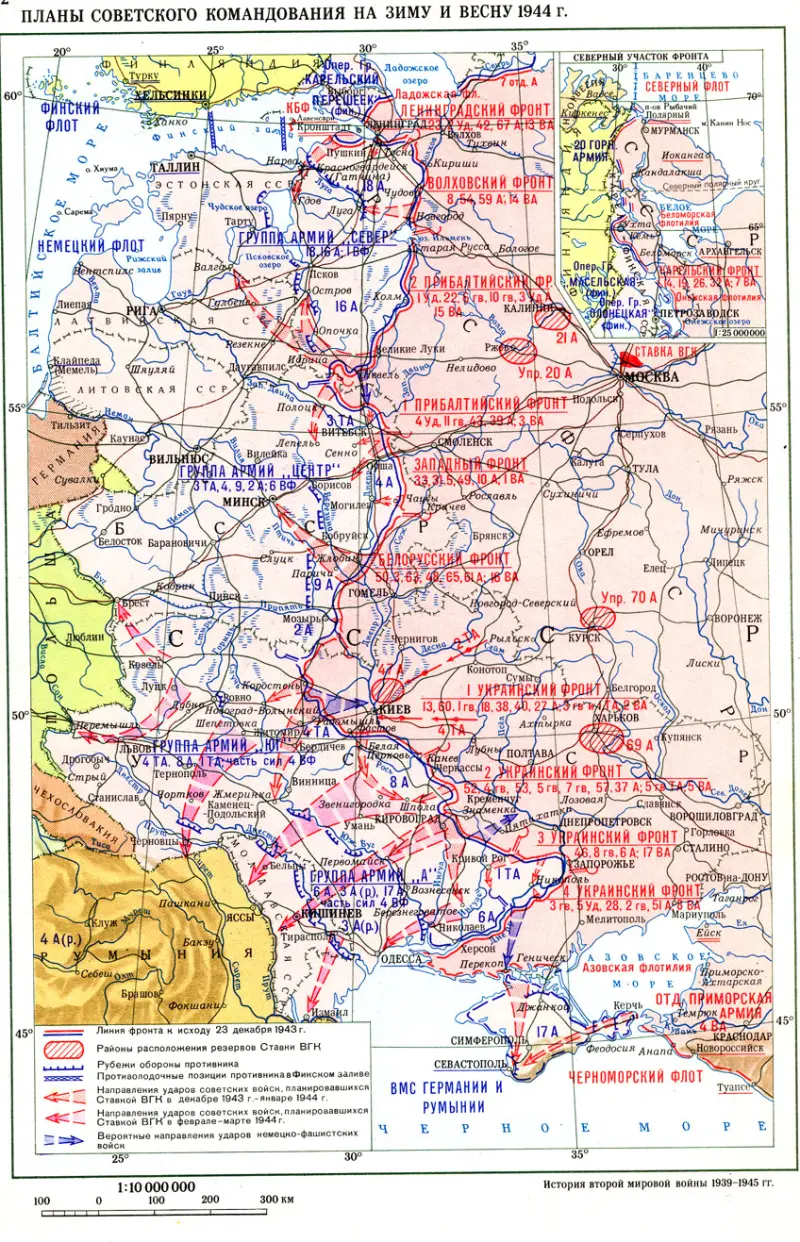
Second hit
During the winter campaign of 1944, large operations of Soviet troops unfolded in the southern direction (The battle for the liberation of Right Bank Ukraine). This did not allow the German command to transfer troops from south to north. On the southern wing of their front, the Germans had one of their largest strategic groupings by the beginning of 1944. The German command assumed that the Russians would continue the offensive begun in 1943 on the southern flank. According to Hitler’s cruelest orders, the Wehrmacht had to hold on to Right Bank Ukraine (food resources), Nikopol (manganese), the Krivoy Rog basin (iron ore) and Crimea, which covered the southern flank of the entire German front, at any cost.
In Right Bank Ukraine there were two German army groups - “South” and “A”, which had 1,7 million soldiers and officers, about 17 thousand guns and mortars, 2,2 thousand. tanks and self-propelled guns, about 1 aircraft.
On our side, the Germans were opposed by the 1st, 2nd, 3rd and 4th Ukrainian Fronts: 2,3 million people, about 29 thousand guns and mortars, more than 2 thousand tanks and self-propelled guns, over 2,3 thousand .combat aircraft.
The first operations of the strategic Dnieper-Carpathian operation began on December 24, 1943. On this day, the troops of the 1st Ukrainian Front under the command of Vatutin began an offensive in the general direction of Vinnitsa. The first days of the Zhitomir-Berdichev operation (Fierce battle for Zhitomir and Berdichev) developed very successfully, the enemy’s defenses were broken through up to 300 km wide and 100 km deep, and Soviet troops advanced to the west, southwest and south. The Germans suffered heavy losses and retreated.
But they soon came to their senses and put up stubborn resistance. Heavy fighting took place on the approaches to Zhitomir, Berdichev and Bila Tserkva. During the offensive, our troops defeated the opposing forces of the German 4th Field and 1st Tank Armies and liberated Radomyshl, Novograd-Volynsky, Zhitomir, Berdichev and Bila Tserkva. Soviet troops reached the approaches to Vinnitsa, Zhmerinka, Uman and Zhashkov.
The commander of Army Group South, Field Marshal Manstein, had to transfer 10 infantry and 6 tank divisions to the area of the offensive of Vatutin’s troops. Having created strike groups in the Vinnitsa and Uman region, the Nazis launched two strong counterattacks on January 10–11, 1944 and were able to stop and push back the Soviet troops.
As a result, by January 14, 1944, the Red Army advanced up to 200 km and captured the Korsun-Shevchenko Wehrmacht group from the north-west. Soviet troops liberated almost completely the Kyiv and Zhitomir regions, partially the Vinnitsa region.
Konev's 2nd Ukrainian Front went on the offensive on January 5, 1944 (How Konev's armies liberated Kirovograd). During the first day of the offensive, Soviet troops partially broke through the enemy's tactical defenses and advanced to a depth of 4 to 24 km. On January 6, the 5th and 7th Guards armies of Zhadov and Shumilov, breaking the stubborn resistance of the Nazis, created a breakthrough up to 70 km in width and up to 30 km in depth.
Formations of Rotmistrov's 5th Guards Tank Army immediately overcame the enemy's second defensive line and reached the Kirovograd area. After stubborn fighting, repelling enemy counterattacks, on January 8, Soviet troops liberated Kirovograd, but were unable to develop an offensive due to the fierce resistance of the Nazis.
Thus, during the Kirovograd operation, Soviet troops defeated the 8th German Army. Kirovograd, an important communications hub, was liberated. At the same time, the right (southern) flank of the German group in the Korsun-Shevchenkovsky area was under threat of attack from the Soviet army. The German command, still hoping to return Kyiv, did not intend to withdraw this large group and level the front.
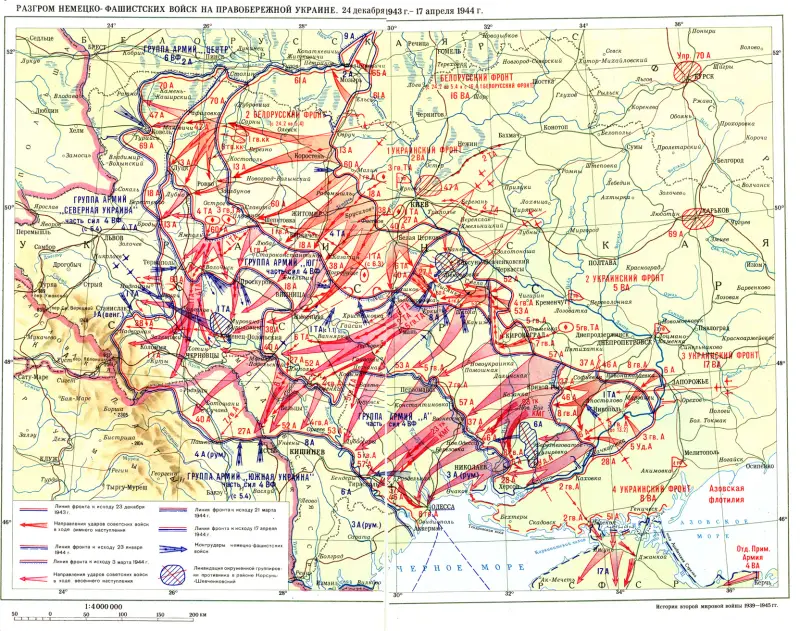
Korsun-Shevchenko operation
On January 12, 1944, the Soviet Headquarters demanded to encircle and liquidate the enemy group in the Korsun-Shevchenko ledge in the near future, to close the left flank of the 1st Ukrainian Front and the right flank of the 2nd Ukrainian Front. The command of the Soviet fronts, by regrouping forces, formed strike groups that were supposed to strike at the base of the ledge. To successfully carry out the operation, superiority over the Germans was created - in manpower by 1,7 times, in artillery - by 2,4 times, in tanks and self-propelled guns - by 2,6 times. From the air, Soviet troops were supported by the 2nd and 5th Air Armies.
On January 14–15, 1944, the troops of the 2nd Ukrainian Front went on the offensive and achieved some successes. However, the Germans organized strong counterattacks, and on January 16, Headquarters pointed out to Konev that the troops were insufficiently organized. Therefore, the start of the Korsun-Shevchenko operation was postponed until January 24.
The command's plan was to deliver counter strikes under the base of the ledge with troops from two fronts and unite in the area of the cities of Shpola and Zvenigorodka. Part of the forces of the 40th and 27th Armies, the 6th Tank Army and part of the forces of the 2nd Air Army of the 1st Ukrainian Front, the 52nd, 4th Guards, 53rd Armies, 5th Guards Tank Army, 5th Air Army and 5th Guards Cavalry Corps of the 2nd Ukrainian Front, as well as the 10th Air Defense Fighter Corps.
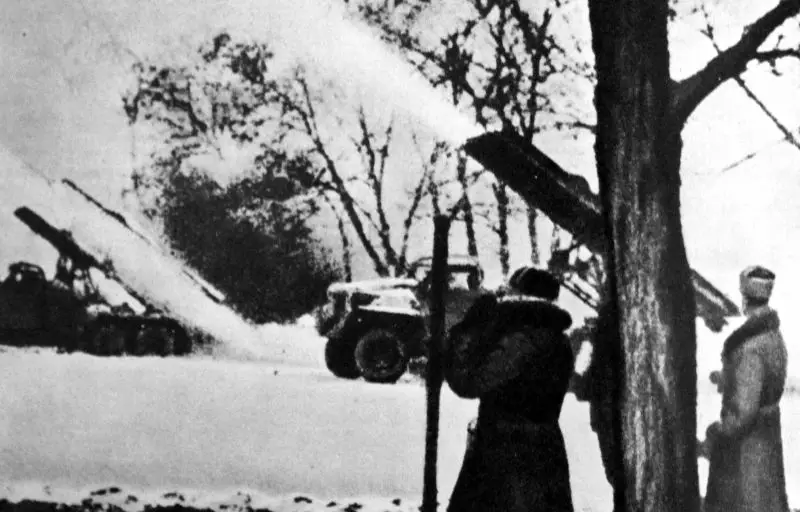
Volley of Soviet Guards mortars under Korsun-Shevchenkovsky
The forces of the parties
Soviet strike forces consisted of 29 rifle divisions, 1 cavalry, 1 mechanized and 4 tank corps. A total of 255 thousand people, 5 guns and mortars, about 300 tanks and assault guns, over 600 thousand aircraft.
The German group included troops of the 1st Panzer and 8th Field Armies: 10 infantry, 2 tank divisions, the SS Wallonia motorized brigade, 4 assault gun divisions and other units. The Germans were supported from the air by aircraft from the 4th Air Force. fleet. In total, the German Korsun-Shevchenko group numbered more than 170 thousand people, 1 guns and mortars, 640 tanks and self-propelled guns.
Also, the Korsun-Shevchensk group could be supported by large armored reserves: in the area west and northwest of Kirovograd (4 tank divisions) and in the area southwest of Okhmatov (3 tank divisions of the 1st Tank Army). The German command planned to hold the Korsun-Shevchenko ledge in order to prevent the adjacent flanks of the 1st and 2nd Ukrainian fronts from closing and to prevent the Russians from reaching the Southern Bug. The salient was considered as a possible springboard for a counter-offensive with the aim of restoring the defensive line along the Dnieper and returning Kyiv.
To relieve the blockade of the encircled group, the command of Group A additionally transferred 1 tank divisions to the 8st Panzer and 5th Armies: 1st, 13th, 16th, 17th Panzer, 1st SS Panzer Division Leibstandarte SS Adolf Hitler", 2 heavy tank battalions (503rd, 506th), 8th tank battalion of the 20th motorized division (as part of the 11th tank division). As of February 1, they consisted of about 60 thousand people, about 550 tanks and assault guns (of which up to 50 Tigers and 150 Panthers). Also in February, the 10th Motorized and 376th Infantry Divisions were additionally transferred to this direction.
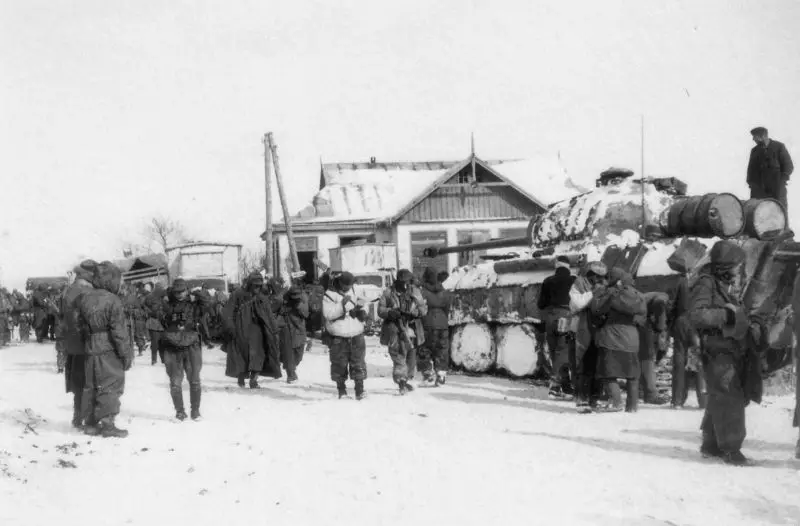
German soldiers and tank Pz. Kpfw. V "Panther" in a Ukrainian village during the Korsun-Shevchenko operation.
Breaking through the defense and creating an encirclement ring
On January 24, 1944, the 4th Guards, 53rd and 5th Guards Tank Armies of the 2nd UV under the command of Generals Ryzhov, Galanin and Rotmistrov, with the support of the 5th Air Army of General Goryunov, began the Korsun-Shevchenkovsky operation.
A day later, the attack force of the 1st UV began its offensive - Kravchenko’s 6th Tank Army, part of the forces of Zhmachenko’s 40th Army and Trofimenko’s 27th Army, with air support from Krasovsky’s 2nd Air Army.
On January 27, 1944, the Germans, using tank divisions, launched counterattacks from the south and north against the advancing forces of the 2nd UV to stop the Russian offensive. The Germans were able to cut off the 20th and 29th Tank Corps of the 5th Guards Tank Army and close the gap in their defenses. Our troops were cut off from the main forces of the front. However, this time the German counterattack did not change the situation as a whole: the strike force continued to move forward, without fear for its rear.
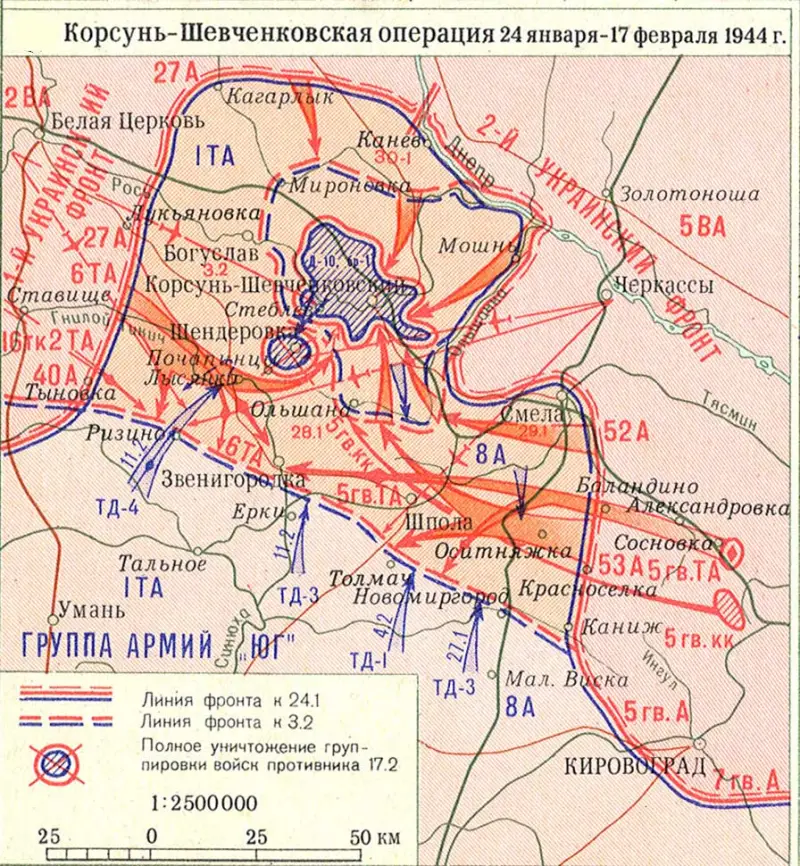
On the morning of January 28, 1944, tank crews of the 5th Guards Tank and 6th Tank armies united in the Zvenigorodka area. The German Korsun-Shevchenko group fell into the cauldron. According to various estimates, there were about 60–80 thousand Wehrmacht soldiers and officers in the encirclement: 2 army corps consisting of 6 divisions and one brigade.
By February 3, units of the 27th Army of the 1st UV and the 4th Guards Army of Ryzhov, the 52nd Army of Koroteev and the 5th Guards Cavalry Corps of Selivanov from the 1st UV formed an internal front to encircle the enemy. A total of 13 rifle, 3 cavalry divisions, 2 fortified areas and other units. The outer ring of encirclement was formed by troops of tank armies, which were reinforced by rifle corps, artillery, anti-tank and engineering units. The flanks of the tank armies were flanked by the troops of the 40th Army of the 1st UV and the 53rd Army of the 2nd UV.
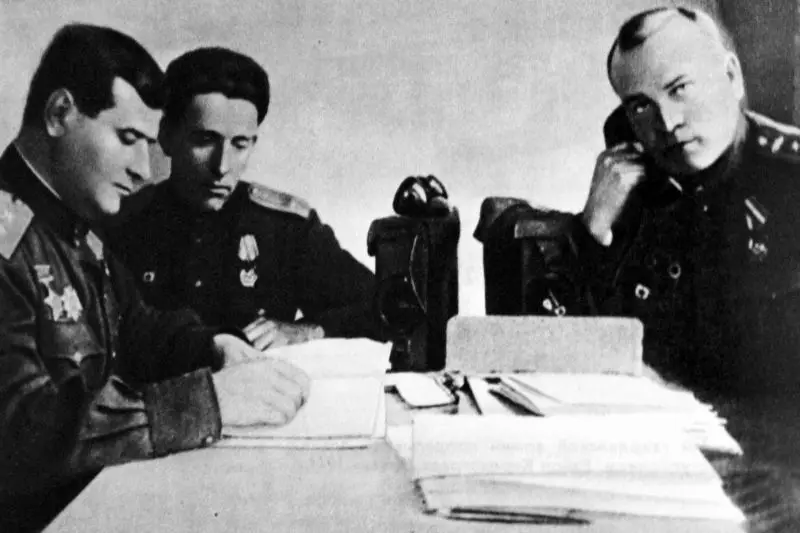
Commander of the 6th Tank Army A. G. Kravchenko (left) with headquarters officers during the Korsun-Shevchenko operation
German counterattacks
Soviet troops sought to dismember and destroy the encircled enemy group. The encircled German troops retreated to more convenient defensive positions, tightened their battle formations, and tried to hold out until the relief forces arrived. Inside the encirclement, heavy fighting took place for Boguslav, which Soviet troops took on February 3, for Olshany - until February 6, Kvitki and Gorodishche - until February 9.
On February 7, the commander of the 11th Army Corps, Wilhelm Stemmermann (Stemmermann Group), was appointed commander of the encircled German troops. The Germans, surrounded, suffered heavy losses: 150 soldiers remained in the regiments (about 10% of the staff). By February 8, the entire territory occupied by the Nazis was under fire from Soviet artillery. Our bomber aircraft continuously attacked the Nazis. The Soviet command, in order to stop the senseless bloodshed, invited the Germans to capitulate. But the Germans rejected the ultimatum, as they were preparing to break through Shenderovka.
The Germans, as during the Battle of Stalingrad, organized an air bridge. Flights of transport aircraft (mainly Junkers 52 and Heinkel 111) began on January 29. German vehicles landed at the site in Korsun. They carried ammunition, provisions, fuel, medicines, etc. They transported the wounded. After February 12, with the loss of airfields, cargo could only be delivered by parachute.
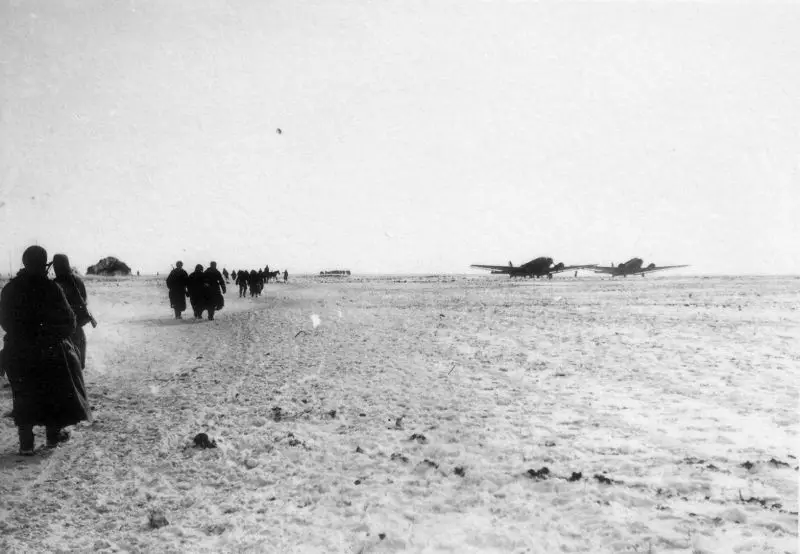
German soldiers and military transport aircraft "Junkers Ju-52" (Ju-52) at the airfield near the village of Shenderivka, Korsun-Shevchenkivskyi district, Cherkasy region
The commander of the German 1st Panzer Army, Hube, promised to help out those surrounded. Hitler also promised Stemmermann release from the cauldron. In order to relieve the encircled troops, the German command, by exposing other sectors of the front, allocated serious forces to strengthen the 8th field and 1st tank armies.
The Germans planned to use concentric strikes to destroy the Russian forces that had broken through (5th Guards and 6th Tank Armies) and free the encircled group. The counteroffensive was scheduled for February 3. However, the spring thaw that began early in southern Russia slowed down the concentration of German troops. Also, complications in other sectors of the Soviet-German front forced some of the troops intended for a counterattack to be sent there.
As a result, the formations arrived piecemeal, and the Germans were unable to organize a simultaneous powerful attack. The German divisions advanced scatteredly and, despite the first successes, did not achieve their goal.
On February 1, 1944, the German 11th and 13th tank divisions began attacks in the Tolmach, Novomirgorod area. On February 2, units of the 3rd and 14th tank divisions began to approach this area. On February 4, the 24th Panzer Division was supposed to arrive, but the high command at the last moment transferred the formation south to the 6th Army. The Germans achieved partial success, but their advance was stopped by stubborn resistance from Soviet troops. The Nazis began to regroup forces for an attack on Zvenigorodka.
On February 4, the 16th (reinforced by the 506th Tiger heavy tank battalion) and the 17th tank divisions and the Beke heavy tank regiment went on the offensive from the Rizino area. On February 6, units of the 1st Tank Division began to approach the battle area (the division completed its concentration on February 10). The strike force of the 1st Tank Army was able to break through the defenses of the Soviet 104th Rifle Corps.
Comfront Vatutin, in order to prevent an enemy breakthrough, threw into battle Bogdanov’s 2nd Tank Army, which had just arrived from the Headquarters reserve. On the morning of February 6, Soviet tank crews launched a counterattack. After stubborn fighting, the Germans were forced to stop the offensive and begin regrouping forces in order to organize a new attack on Lysyanka.
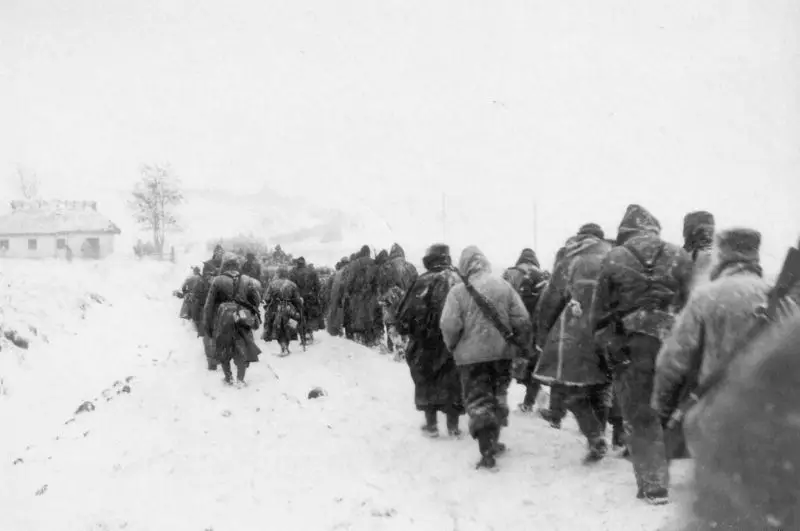
Column of the retreating German troops in Ukraine during the Korsun-Shevchenko operation
Having strengthened and reorganized the strike force, the Germans continued trying to save the Korsun-Shevchenko group of troops. On February 11, units of the 11th, 13th and 14th tank divisions began an attack on Zvenigorodka. The Germans advanced slightly, but further attacks were repulsed.
On February 11, troops of the 1st, 16th, 17th Panzer Divisions and the 1st SS Panzer Division "Adolf Hitler" attacked from the Rizino area. In this direction, due to the stronger grouping in composition and number of tanks, the Germans achieved more and broke through to Lysyanka. On February 12, the Germans were generally inactive due to a lack of fuel, ammunition, and strong resistance from Russian troops. They repulsed enemy counterattacks.
On February 13, the 16th Panzer Division and Beke's heavy tank regiment were able to advance another 12 km, and about 10 km remained before Stemmermann's group. On February 14–16, the strike force tried to move forward further, but did not achieve any visible success due to the strong resistance of our troops. The strike capabilities of the German group were exhausted. There were only about 7 km left to the German encirclement.
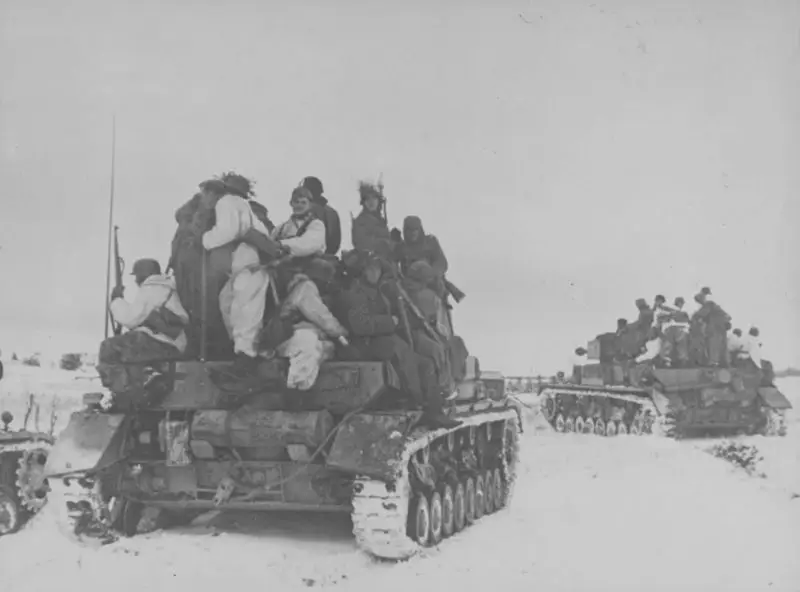
German tanks Pz. Kpfw. IV with soldiers on armor during the Korsun-Shevchenko operation
Liquidation of the boiler
Meanwhile, the surrounded German troops tried to break through to their own. In the Steblevo area, the German command was gathering forces (72nd Infantry Division) for an attack on Shenderovka in order to connect with the strike group of the 1st Tank Army. On February 12, the Germans made a successful night attack, broke through the defenses of the 27th Soviet Army and made their way to Shenderovka. As a result, the distance between German troops in Lysyanka and Shenderovka was reduced to 10–12 km.
The Soviet Headquarters, in order to unite the efforts of all the troops allocated to eliminate the encircled enemy, transferred the 27th Army to the 2nd UV. The 27th Army was strengthened. On February 13–14, troops of the 5th Guards Tank Army attacked the Nazis in the Steblevo area. At the same time, the regrouping of the main forces of Rotmistrov’s tank army began in the area of Steblevo and Lysyanka.
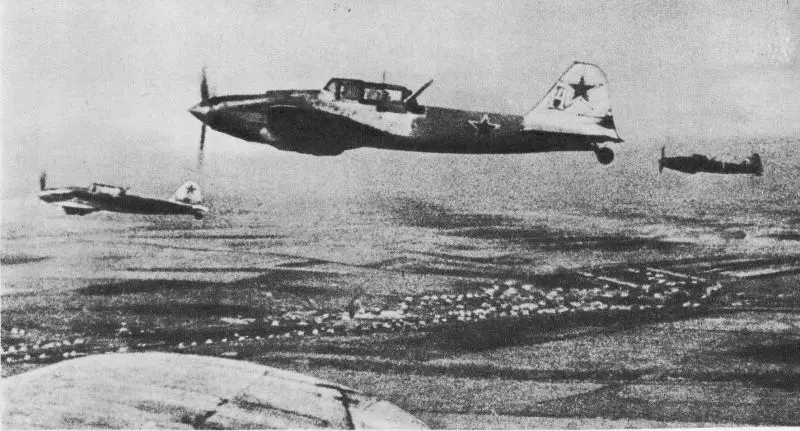
Soviet attack aircraft Il-2 17 th air army sent to strike at the retreating enemy columns during the Korsun-Shevchenko offensive operation
The situation of the surrounded German group became critical. On February 12, the length of the perimeter of the territory they occupied was reduced to 35 km. On February 14, Soviet troops occupied Korsun-Shevchenkovsky.
On February 15, the commanders of the encircled German corps, Lieb and Stemmerman, decided to make a final breakthrough, otherwise death. In the vanguard was Lieb's corps, the most combat-ready forces (corps group "B", 72nd division and 5th SS Wiking division, Wallonia brigade), it was covered by Stemmermann's corps (57th and 88th infantry divisions). The group had about 45 thousand combat-ready people. On February 15, there were stubborn battles in the area of the villages of Komarovka, Khilki and Novaya Buda; the success of the breakthrough depended on control over them.
On the night from February 17 to February 18, the Germans in three columns went on a desperate breakthrough. Part of the group, suffering heavy losses from the shelling of Soviet artillery and trying to cross the water barrier with improvised means (people died from hypothermia), was able to get through to their own. Killed and General Stemmerman. At the same time, the Nazis had to throw heavy weapon, artillery and a large amount of various equipment.
According to Soviet data, German losses in the encirclement amounted to 55 thousand people killed and about 18 thousand prisoners. According to German information, 35 thousand people emerged from the cauldron.
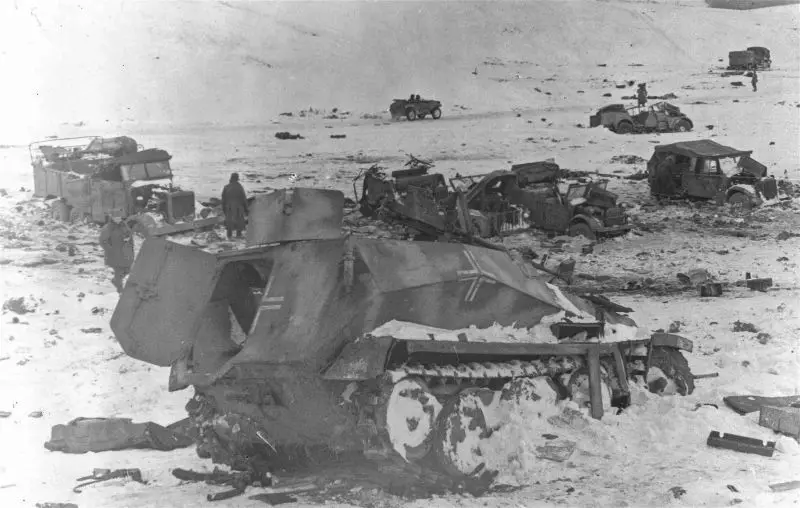
German equipment destroyed during the Korsun-Shevchenko operation of Soviet troops. In the foreground is an armored personnel carrier Sd. Kfz. 250
Thus, the Red Army defeated the Korsun-Shevchenko group of the enemy. The German army suffered a heavy defeat and suffered heavy losses in manpower and equipment, which further worsened the situation on the extended German front.
The Red Army radically improved the situation at the junction of the 1st and 2nd Ukrainian fronts. This created the conditions for the development of an offensive for the further liberation of Right Bank Ukraine, for the movement of our troops to the Southern Bug and the Dniester.
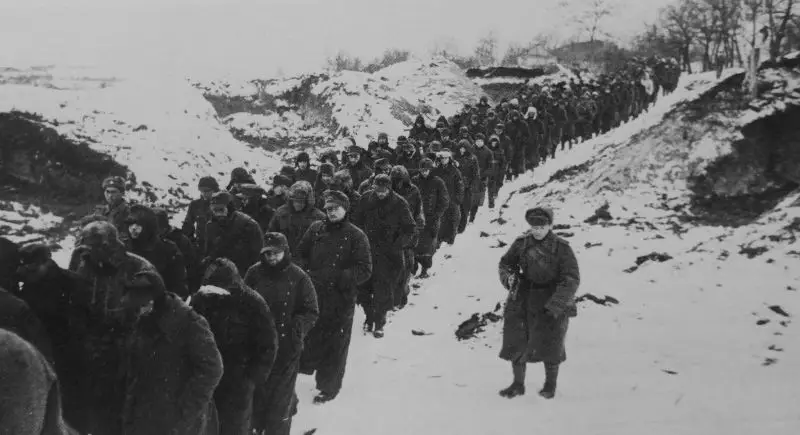
Red Army soldiers escort a column of German soldiers captured during the Korsun-Shevchenko offensive operation in the countryside. February 1944
Information